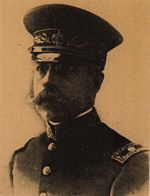The División de Occidente issue
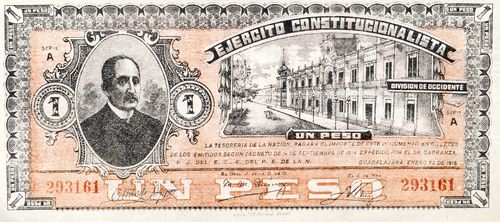
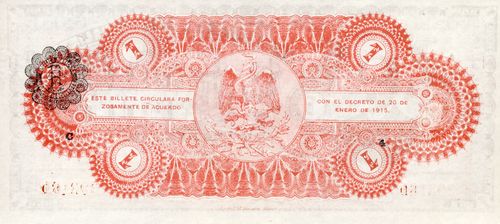
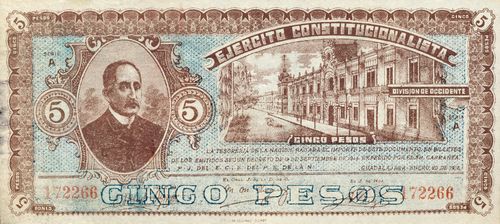
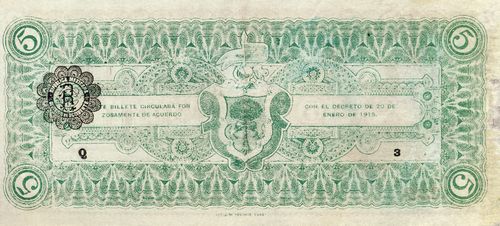
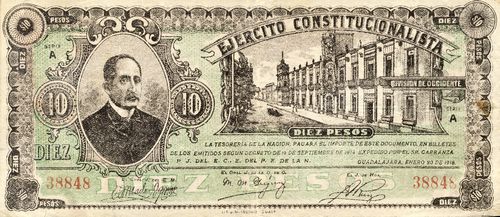
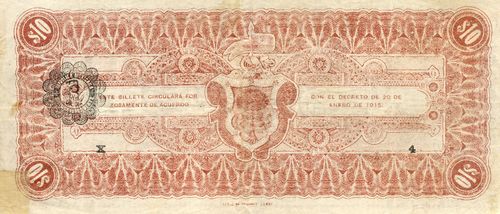
| date on note | Series | from | to | total number |
total value |
||
| 20 January 1915 | $1 | A | 1 | 499999 | 500,000 | 500,000 | includes numbers 4071 to 499888 |
| $5 | A | 1 | 199999 | 200,000 | 1,000,000 | includes numbers 1670 to 199559 | |
| $10 | A | 1 | 49999 | 50,000 | 500,000 | includes numbers 318 to 49016CNBanxico #11326 | |
| $2,000,000 |
These were also printed by J. M. Iguíniz, and had a portrait of General Ramón Corona MadrigalRamón Corona was born in Tuxcueca, Jalisco in 1837. He worked in business at an early age, but when the War of Reform began, he joined the Liberals as a lieutenant and after a number of battles, he became Brigadier General at the age of 28. He fought against the French with incredible valour, ability and cleverness, and was undefeated. While most of the states of the Republic were occupied by the French, the State of Sinaloa, defended by General Ramón Corona, was never conquered. Maximilian surrendered to General Corona at the Cerro de las Campanas. When the war against the French ended, and when Lerdo de Tejada was president, Placido Vega and Manuel Lozada organized an army of 15,000 men to take control of the country, and Corona, with only 1,500 men, defeated their army. A short time later, he was appointed Foreign Minister of Mexico to Spain and Portugal. After twelve years of absence from his fatherland, he returned and was elected governor of Jalisco where he served from1 March 1887, until the day of his death, 11 November 1889. He was murdered by a madman named Primitivo Ron, a 22 year old student who afterwards committed suicide., a native of Jalisco who fought the French and accepted the surrender of the Emperor Maximilian, and a view of the Palacio de Gobierno in Guadalajara on the front.
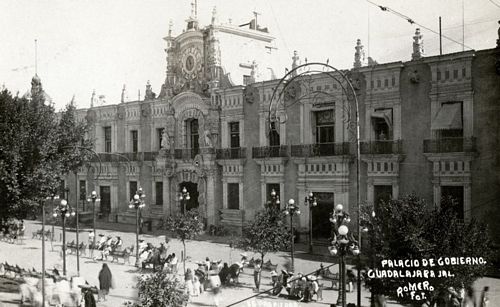
They bear more than a passing resemblance to Obregón’s Pagaduría del Cuerpo del Noroeste issue, also from Guadalajara. As well as Diéguez’ signature, they had the signatures of Coronel Amado Aguirre as Chief of General Staff and A. Ruiz as Jefe de Hacienda. The text stated that the Tesorería de la Nación would redeem these in notes of Carranza’s 19 September issue.
|
He remained loyal to Carranza, fighting the Villistas in both Jalisco and, later, other states. In 1923 and 1924 he supported Adolfo de la Huerta’s revolution, fighting in Guerrero, Oaxaca and Chiapas, until captured and executed in Tuxtla Gutiérrez on 20 April 1924. |
 |
|
At the end of May 1914, at the head of a few men, he joined the Constitutionalist forces of General Lucio Blanco, who were advancing on Tepic. Soon after, General Diéguez incorporated him into his General Staff with the rank of Major. On 14 July 1914, General Obregón appointed him responsible for gathering the extraordinary contribution of five million pesos that had been imposed on the real estate of the state; Aguirre fulfilled this commission efficiently and relentlessly, in 15 days he raised almost three million pesos. He was military chief of Guadalajara and head of military operations in the state; at the end of 1914, faced with the evident break with the Villistas, Diéguez commissioned Aguirre to establish a vanguard force on the borders of Colima and he actively fought with Villistas. He was the architect of the victory in Santa Ana Acatlán, for which he obtained the rank of Brigadier General. After defeating the Villistas in Guadalajara, Aguirre set out along with Diéguez to join Obregón in Irapuato, Guanajuato. He was seriously wounded in the battle of La Trinidad, managing to recover in a few months, and joining Obregón in the task of reorganizing the National Army. In 1917 he was elected as a deputy to the Constituent Congress. He was then elected senator for Jalisco, a position from which he separated to serve as undersecretary of Agriculture and Development, from 1917 until February 1920. In April of that year, Aguirre was in Guadalajara promoting Obregón’s campaign. Diéguez tried to convince him to break with Obregón and when he refused, he had to flee to the mining region of Etzatlán, where he organized a small armed force in favor of the Agua Prieta rebellion. When Diéguez was captured, Aguirre intervened with Obregón so that he would not be shot. Therafter Aguirre held a number of positions in the Mexican government. During the interim of Adolfo de la Huerta, he was manager of the Caja de Préstamos para Obras de Irrigación y Agricultura. He was Secretary of Communications and Public Works from 1921 until November 1924. On 13 November 1924 he was promoted to Brigadier General and the following year became director of the Heroico Colegio Militar. He was governor of the territory of Quintana Roo from 1924 to 1925, ambassador to Chile and representative to Brazil and Costa Rica, and governor and military commander of the Baja California Sur district from 1927 to 1929. He died in Mexico City in 1949. |
 |
|
Adolfo Ruiz came from Sonora to take up the post of Jefe de Hacienda in late August 1914El Reformador, Tomo I, Núm. 18, 21 August 1914. While at Irapuato on a mission to Mexico City Ruíz was assassinated by the Jefe de las operaciones in Guanajuato, General Luis González GutiérrezLuis González Gutiérrez was born in Michoacán 1875. He rose in arms against Huerta in April 1913, fought faithfully for Gertrudis G. Sánchez who made him General de Brigada on 16 February 1920. He died in 1973.. González was condemned to death, but subsequently had his sentence commuted to 20 years in prisonEl Informador, Año I, Tomo I, Núm 15, 20 October 1917. |
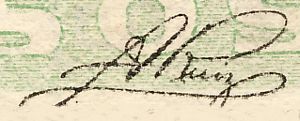 |
Later, in January 1916, Dieguez wrote to Obregón (and hence Carranza) explaining that in November 1914, when he was lacking communication with Obregón's headquarters and the Primera Jefatura, he had reorganised his five battalions and five regiments into the División de Occidente and also issued $2,000,000 in paper currency. He asked for retroactive authorisation for his actions, and Carranza replied on 31 January, stating that he had also ordered the Secretaría de Hacienda to change these notes in due course for Gobierno Provisional notesEl Pueblo, Año III, Tomo I, Núm. 468, 2 February 1916; Boletín Militar, Tomo V, Núm. 387, 3 February 1916.
Diéguez also felt the need for higher value notes as he used some Gobierno Provisional de México 50 pesos notes without signatures but with an overstamp dated 28 January 1915 with Diéguez’ signature that stated that they were of obligatory acceptance.
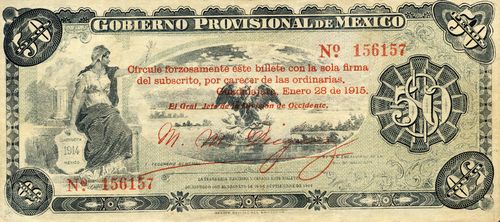
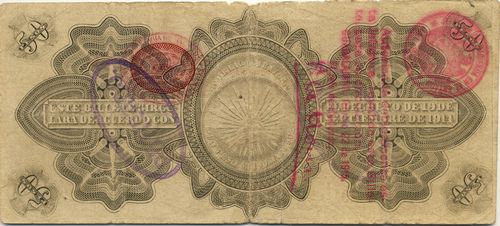
| from | to | total number |
total value |
||
| $50 | includes number 151466CNBanxico #11329 to 156157 |
Some of these (such as the example above) were later revalidated by the Jefatura de Hacienda.
These were still being used in April 1916 when the Jefatura de Hacienda in Guadalajara announced that they would continue exchanging them.

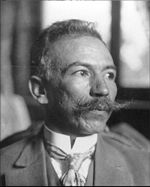 Manuel Macario Diéguez Lara was born in Jalisco on 10 March 1874 but by 1906, at the age of 32, he was working as an overseer for the Cananea Consolidated Copper Company mine in Cananea, Sonora. He was one of the leaders of the famous strike there and was subsequently sentenced to fifteen years in the infamous prison of San Juan de Ulúa. When Madero became president Diéguez was released and returned to Cananea where he became presidente municipal. After the decena trágica he joined Obregón’s Cuerpo de Ejército del Noroeste and rose to be a general. On 12 June 1914 he was appointed governor of his native state.
Manuel Macario Diéguez Lara was born in Jalisco on 10 March 1874 but by 1906, at the age of 32, he was working as an overseer for the Cananea Consolidated Copper Company mine in Cananea, Sonora. He was one of the leaders of the famous strike there and was subsequently sentenced to fifteen years in the infamous prison of San Juan de Ulúa. When Madero became president Diéguez was released and returned to Cananea where he became presidente municipal. After the decena trágica he joined Obregón’s Cuerpo de Ejército del Noroeste and rose to be a general. On 12 June 1914 he was appointed governor of his native state.